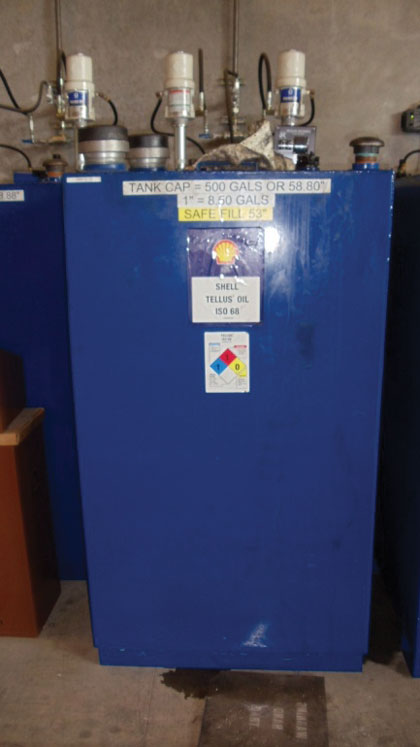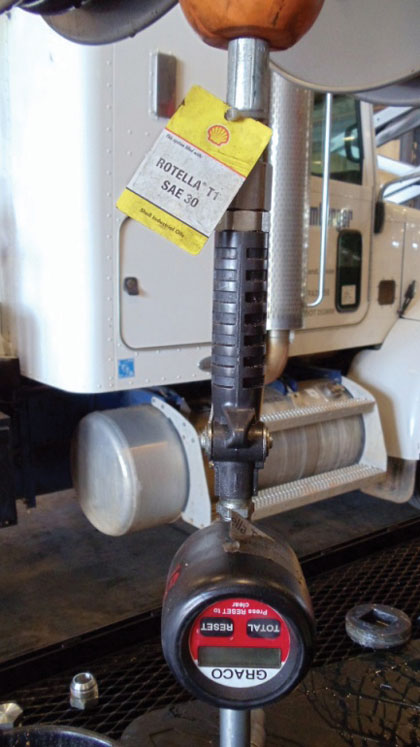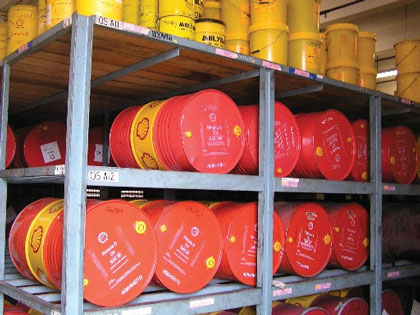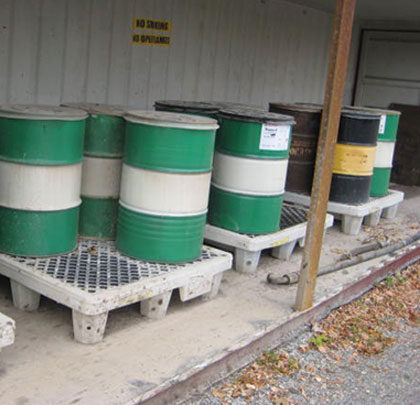Improving operational efficiency and safety along with lubricant storage and dispensing are important to everyone in a shop or jobsite. Safety issues can be hazardous to employees and increase medical expenses and lost productivity. Contaminated lubricants can cause unnecessary maintenance issues with vehicles and equipment, as well as lost time and money. Here are some tips to improve safety and to keep lubricants from becoming contaminated.

Proper tank labels.
SHOP AND JOBSITE SAFETY
It is good to regularly conduct audits of your facility to improve operational efficiency. Maintaining an audit schedule may help improve facility safety, provide insights to lubrication management, and even reduce potential errors in application due to confusion or mislabeling.
The most important area to improve is the safety of the facility and that audit should begin with the parking lot. Simple steps like ensuring personal vehicles are backed into stalls, that there is clear signage reminding visitors of PPE (Personal Protective Equipment) requirements, and that muster stations are clearly marked will help reduce accidents and potential confusion in an emergency.
Chocking wheels of vehicles when parked on site or in service, immediate cleanup of spills (no matter how minor), and having access to current Safety Data Sheets on all lubricants and chemicals are among some of the simple things that can be done. Technicians should also use a “Lock Out-Tag Out” system when working on equipment.
Safety practices extend into the facility or jobsite as well by ensuring all visitors are registered and provided with PPE. All exits, shelters, eyewash stations, first aid stations, and fire extinguishers should be clearly marked and have current certifications. Improved cleanup regimens will also help curb accidents. Ensure that hoses and power cords are not left on the floor and that used rags and absorbent pads are disposed of properly. Be sure that lighting is maintained for good vision.

Properly labeled dispensing nozzles.
LUBRICANT STORAGE AND USAGE
Lubricant storage is also an important piece of operational efficiency and machinery protection. The first step is to ensure that all bulk lubricant and coolant storage tanks feature double walls, drain valves for contaminant removal, sight gauges to determine fluid levels, desiccant breathers, locked fill points, and in-line filtration. All storage tanks should be properly labeled with the specific lubricant type, brand, and viscosity grade of lubricant. All drums and kegs stored outside should be stored undercover and have drum covers. If drum covers are not used, drums should be blocked with bungs at the 3 and 9 o’clock positions to allow for proper drainage.
In addition, ensure that all lubricants and coolants meet OEM requirements, and if possible use a single lubricants supplier, such as Shell Lubricants, to minimize potential cross contamination due to miscellaneous lubricants, greases, and coolants entering the shop or jobsite. The supplier can also verify that all lubricants used meet your individual OEM requirements and help you order the correct lubricants for your vehicles, equipment, and machinery. A good supplier can also provide advice on special storage requirements when needed.

All totes, drums, and kegs in use should be stored inside and stored horizontally.
Implement a similar strategy for filters. Store each filter in original packaging for easy identification and keep in a clean environment. This ensures only the correct filters are utilized. Combined, all of these actions may also lead to lower operational costs.
Another step in an operational efficiency audit is to minimize confusion in applications. Ensuring all dispensing handles are properly labeled with product name and viscosity grade is a good first step. Color coding the bulk storage, dispensing handles, fill points, and transfer containers for each fluid is also an excellent practice. Utilizing only dedicated, sealed containers for transfer and top-off will also minimize contamination from dirt, dust, and non-compatible fluids. Always collect and properly dispose of used oil and filters in accordance with local and federal requirements. Maintain records of the proper disposal. ■
For More Information
Jeff Priborsky is a technical advisor with Shell Lubricants. Shell Lubricants can help you evaluate and improve your shop operations. If you need further details, contact Shell Lubricants at 1.800.BEST.OIL or your Shell distributor.
Modern Contractor Solutions, January 2015
Did you enjoy this article?
Subscribe to the FREE Digital Edition of Modern Contractor Solutions Magazine!


